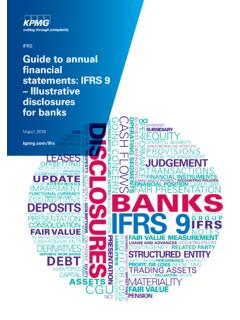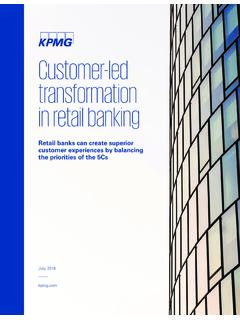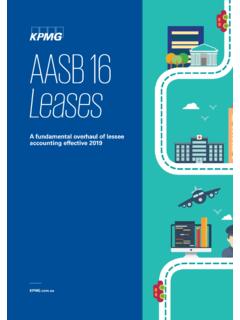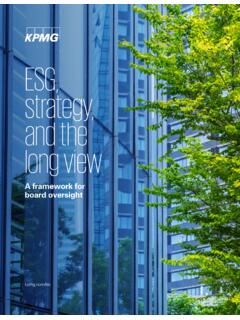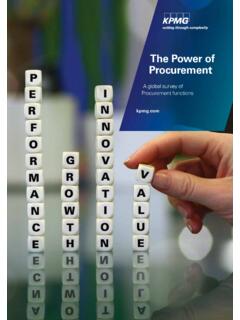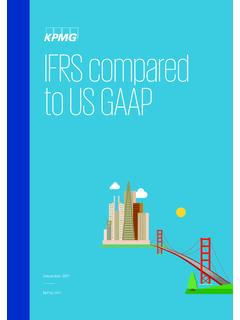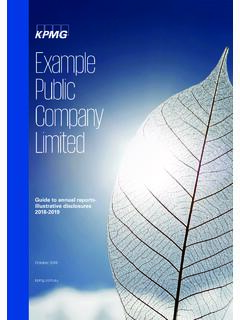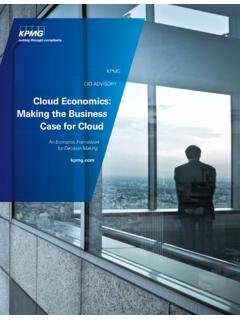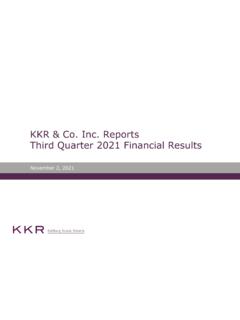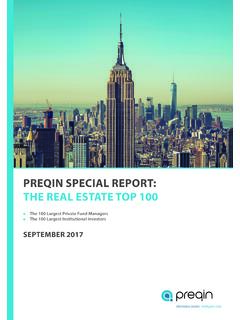Transcription of Evaluating private equity s performance
1 Evaluating private equity s performance Approach the value bridge with cautionKPMG s Global Valuation Institute (GVI) is pleased to introduce its seventh management paper since the launch of our research agenda. Authored by Peter Morris, a former banker with Morgan Stanley, this paper discusses different approaches to Evaluating private equity performance , a subject that has been fraught with uncertainty and controversy for many Global Valuation Institute recognizes that valuation is a constantly evolving discipline that has been shaped by practical and theoretical advances. Many high quality research papers on valuation subjects never find their way to influencing the evolution of standards and practice due to a lack of exposure to practitioners. In addition, inertia and entrenched habits and interests make necessary change goal is to act as a catalyst for the adoption of breakthrough valuation research.
2 To this end, KPMG s GVI benefits from the expertise of an Academic Advisory Board comprised of professors from Northwestern University in the US and Oxford University in the UK. This Board designs a research agenda and selects and reviews the research we Global Valuation Institute works closely with researchers to present their managerial papers in a format that is understandable to a broad range of business professionals. This includes illustrative papers with applications and/or case studies. Through this process, we keep KPMG s global network of 1,300 valuation professionals informed of emerging valuation issues and offer other interested parties a tool to monitor new and interesting developments in use of the value bridge in private equity has been subject to controversy, notably within the Limited Partners community. Although the academic literature does not support a link between value creation and the value bridge in buyouts, the latter continues to be used in practice.
3 In this paper, the author explains the shortcomings of the value bridge and illustrates how economic performance should be interpreted. This paper is the seventh in a series that has been sponsored by KPMG s Global Valuation Institute. As practitioners, we trust that you will find these of read more about KPMG s Global Valuation Institute and download the full series, visit Courtois Partner, KPMG in LuxembourgDoug McPhee Partner, KPMG in the UKJean Florent Rerolle Partner, KPMG in France2 2016 KPMG International Cooperative ( KPMG International ). KPMG International provides no client services and is a Swiss entity with which the independent member firms of the KPMG network are equity (buyout) firms are well paid for what they do. Supporters justify these high rewards by pointing to the way buyouts create value. They argue that the private equity ownership model allows buyout firms to run companies better than is possible under other ownership models, making the overall economic pie bigger.
4 This is both socially and privately valuable, so it deserves high rewards. Value creation therefore plays a key role in the private equity story and should be measured in a way that is both accurate and meaningful. This requires looking beyond familiar headline measures of return such as internal rate of return (IRR) and cash multiple. Unfortunately, a standard tool among private equity practitioners fails this test. This simple model, known as the value bridge, is accurate in that its numbers add up. But although the numbers in the value bridge are mathematically true, they need to be interpreted with care. The value bridge fails to reflect how much debt contributes to private equity returns, because it captures only one dimension of debt. And because it looks at operating performance in absolute terms, rather than relative to peers, the value bridge fails to measure if a company has been run better than its peers.
5 A better way to measure value creation in private equity is already available in the academic literature. It starts from economics, not accounting, and breaks down the profit on a buyout into three main factors: the return on a stock market comparable, the impact of high debt, and a residual that may include the effect of running the company better relative to peers. Not everyone in private equity has an incentive to use this more-meaningful approach. But investors and policy makers should take an Morris March 2016 Whole or partial funding for this paper has been generously provided by KPMG s Global Valuation Institute. It is an expanded version of an article that was published in Financial World (October/November 2014, www. ). The author is an independent researcher with no academic affiliation and can be reached at He would like to thank all those who agreed to be quoted and two referees for their comments.
6 2016 KPMG International Cooperative ( KPMG International ). KPMG International provides no client services and is a Swiss entity with which the independent member firms of the KPMG network are affiliated. 2016 KPMG International Cooperative ( KPMG International ). KPMG International provides no client services and is a Swiss entity with which the independent member firms of the KPMG network are 06 The value bridge 08 What is wrong with the value bridge? 11 Who uses the value bridge? 14A better way: market-based value creation 18 Who uses the market-based approach? 24 Conclusion 25 Selected references 27 2016 KPMG International Cooperative ( KPMG International ). KPMG International provides no client services and is a Swiss entity with which the independent member firms of the KPMG network are funds and other private equity investors pay high fees to the private equity firms that manage their money.
7 (In this article, private equity refers only to buyouts.) How high? It is hard to capture this in one figure, but four of the largest private equity firms now file reports with the US Securities and Exchange Commission (SEC), which give some indication. Table 1 shows that, since 1976, fees and carried interest have cost investors in these managers funds between 7 percent and 14 percent per These four managers have historically received between one-quarter and one-third of the gross returns that they who work in private equity both fund managers and investors say that although these costs are substantial, they represent good value, and not just because investors receive high returns. How the returns are generated is even more important. private equity sees itself as a cut above the rest of the investment pack. Where most investment managers generate returns through some combination of market timing and/or stock picking, private equity says it does something harder and more valuable: it creates value, meaning it makes the overall economic pie bigger than it otherwise would be.
8 The term value creation lacks a clear definition. Different people use it to mean different things. What this article means by private equity value creation is only that part of an investment return that comes from making the economic pie bigger than it otherwise would be. This embraces a full range of familiar private equity strategies: for example, running a Earliest yearCommitted capital (bn)Capital invested (bn)Value (bn)Gross IRRNet IRRFees + carry [Fees + carry] as % of gross IRRA pollo1990$ $ $ $ $ $ $116 . 927%19%8%30%KKR1976$ $ 6 $13 7. 826%19%7%26%Average30%21%9%30%Table 1 Major private equity firmsImplied cost of fees and carry, to December 2014 Funds includedApollo Funds I-VIIIB lackstone BCP IV-VI, BEP I, Tactical Opportunities, Strategic PartnersCarlyle Fully-invested fundsKKR Legacy funds 1976-96 and Included FundsSource: 10K filings, author calculationsIntroduction1 These figures are likely to exclude additional fees paid to managers, such as the fees that portfolio companies pay for monitoring, financing, etc.
9 The annualized cost is expressed here in terms of an internal rate of return (IRR), which may not be directly comparable to more-conventional measures of return/cost. The annualized cost that these private equity managers SEC filings imply is generally similar to the 7 percent figure estimated in Phalippou (2009). On November 16, 2015, CalPERS, a major pension fund investor in private equity , held a private equity Workshop. This included a presentation in which slide nine showed the estimated cost of investing in private equity as 7 percent per annum. Presentation available at 6 Evaluating private equity s performance 2016 KPMG International Cooperative ( KPMG International ). KPMG International provides no client services and is a Swiss entity with which the independent member firms of the KPMG network are company more efficiently, growing it faster, breaking up a conglomerate, creating bigger groups through a buy-and-build approach, and so equity value creation in this sense excludes several items that are regularly referred to as value creation.
10 These include a general market increase in profits, market timing, stock picking and financial engineering. The returns that come from these sources are real enough. Such returns will help pay for pensions over the long term. But they do not come from making the economic pie bigger than it otherwise would be. private equity managers charge higher fees than traditional investment managers. To justify this, private equity managers should be able to demonstrate that their investments have outperformed. Merely matching the performance of non- private equity companies does not support incremental fees. Therefore, this article distinguishes private equity value creation from value creation generally. The latter comprises the overall change in value, while the former reflects the incremental performance relative to non- private equity two most-familiar measures of return in private equity are the internal rate of return (IRR) and the cash multiple.
